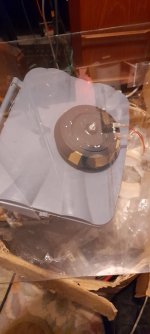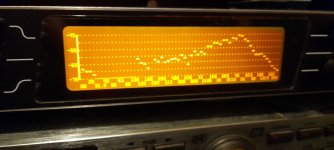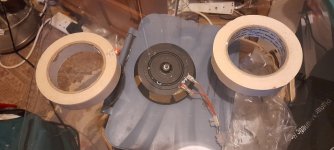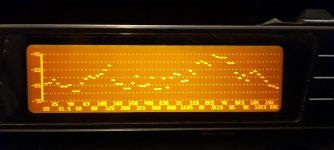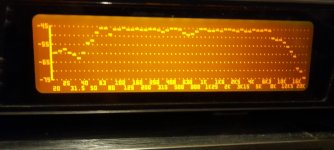First picture is the glass resting on my hdn8 screw point.
The second is the response at about 50cm.
The third picture shows the response you would get from a side angle.
But not directly from the side.
You tend to get a rising response to a peak in the HF.
Any reflections from close side walls or ceilings and floors will give you a very painful shock with some female vocals.
All the reflections will hit you at about the same time.
Not just from the nearest wall but the opposite wall as well .
This is also the response I would expect from panels turned so that the edges face you.
That is why I suggested toeing them out a bit for a flatter response.
Steve.
The second is the response at about 50cm.
The third picture shows the response you would get from a side angle.
But not directly from the side.
You tend to get a rising response to a peak in the HF.
Any reflections from close side walls or ceilings and floors will give you a very painful shock with some female vocals.
All the reflections will hit you at about the same time.
Not just from the nearest wall but the opposite wall as well .
This is also the response I would expect from panels turned so that the edges face you.
That is why I suggested toeing them out a bit for a flatter response.
Steve.
Attachments
Was my idea of facing a pair of DMLs together for DML bass too looney for even this discussion ;-)Since you posted your subs ...
What would stand in the way?
A larger more powerful exciter?
One could support it with a brace?
Back in the 1980s David Lucas advertised a DIY kit for an electrostatic bass panel in Speaker Builder and Audio Amateur.
I remember that it used a number of electrostatic panels in parallel.
I just found a website that described it: The David Lucas SHOCKWAVE Electrostatic Subwoofer.
...sometimes the gentle winds of the past carry messages for us.
I did order an electrostatic speaker kit from David Lucas, but it got smashed up in transit. David graciously accepted the return and I moved on to some other OB speaker project.
Attachments
Yes it is a kind of Walsh driver. I made it perhaps 20 years ago. It was made from a cone speaker. The membrane was removed. I glued at the voice coil a cone made of those plastic foils for gift wrapping. The result was a not too bad 360° medium driver. 300Hz to 5kHz if I remember. It was the unique pair as I didn't find at this moment how to improve it.Christian.
That looks like a Walsh clone?
If so, no.
Steve.
How cluttered or how free is your room, where you do these experiments? Is the glass panel fixed or just standing free?First picture is the glass resting on my hdn8 screw point.
The second is the response at about 50cm.
The third picture shows the response you would get from a side angle.
But not directly from the side.
You tend to get a rising response to a peak in the HF.
Any reflections from close side walls or ceilings and floors will give you a very painful shock with some female vocals.
All the reflections will hit you at about the same time.
Not just from the nearest wall but the opposite wall as well .
This is also the response I would expect from panels turned so that the edges face you.
That is why I suggested toeing them out a bit for a flatter response.
Steve.
By the way, from Briggs book on diffusers,
It is a reverberation device. with an exciter and some sensor on the edge (top edge). Searching papers about plate vibrations, I found dealing about making a synthetic reverb by simulation of a plate.Chdsl.
Thank you very much for the book link.
Quite a bit is lifted from my Loudspeaker book.
And I noticed while quickly browsing through, that on page 175 there is a drawing of an acoustic resonator, which is so close to a dml panel design.
If only he had use a different material without holes.
Steve.
I like the last sentence : "What is distortion, what is perfection?"
That was created by Mr. Cooke, who helped to write the book for Briggs. It'd be nice to find any details of Dr. Kuhl's and Mr. Lauridsen's designs, patents or any writing.It is a reverberation device. with an exciter and some sensor on the edge (top edge). Searching papers about plate vibrations, I found dealing about making a synthetic reverb by simulation of a plate.
I like the last sentence : "What is distortion, what is perfection?"
View attachment 1115300
That "DML" is fixed, not hanging by threads. 🙂
His name is Holger Lauridsen, born in 1920, earned an MSc in 1944, worked for the Danish Broadcasting Corporation, died in 1956 due to a heart attack while at work.
Chdsl.
The glass panel was resting on top of the exciter as shown in the photo.
The second pic is of the response with the exciter thread touching the edge of the glass.
Everything below about 1.5k was me moving about and putting the microphone and exciter down.
There was very little output below 1k.
Pic 3 was with the exciter placed in the middle on the surface .
The output shoots off the scale with a much higher output than on the side edge.
Microphone in the same position.
The rolls of tape in the first picture were placed there to help stop the glass ringing while playing music.
A lot of damping is advertised if using glass.
Steve.
The glass panel was resting on top of the exciter as shown in the photo.
The second pic is of the response with the exciter thread touching the edge of the glass.
Everything below about 1.5k was me moving about and putting the microphone and exciter down.
There was very little output below 1k.
Pic 3 was with the exciter placed in the middle on the surface .
The output shoots off the scale with a much higher output than on the side edge.
Microphone in the same position.
The rolls of tape in the first picture were placed there to help stop the glass ringing while playing music.
A lot of damping is advertised if using glass.
Steve.
Attachments
Oh, I should've posted that separately. Lot of people/companies are trying to sell omnidirectional speakers with all kinds of diffusers, and at very high prices. Briggs statement that such diffusers don't do much in ordinary rooms is quite true. I have heard music just above such a diffuser, just the same as I heard it standing few feet away. The diffuser should sort of block the sound going up, and direct it towards the room, but such effect is not felt.Chdsl.
I'm not sure about what you mean by showing the quote about diffusers?
Steve.
Briggs was a special person, a piano player, and heard well at his age.
Here, we are actually searching for the omnidirectionality on our experiments with the DMLs. I suppose omnidirectionality can be achieved with DMLs. One can hear the same sound standing in line with the panels. Actually, I can hear the same sound from a commercially available box speakers standing perpendicular to the speakers, or behind them. Well, my ears are not as good as Briggs, but I trouble my wife with those tests. She helps with these tests in the weekends. Anyway, the thing is these DML panels are very bad WAF, so right now is the search is for high WAF solution, rather than the type of material. Ammos speaker is high WAF. My wife thought it is a lamp.
Oh yes, you are right, that reverberating panel is floating and hangs on springs. But, that one is very bad WAF. 🙂
On page 38 you can see the concrete drainage pipe with diffuser (I would call it a reflector).Here's A to Z in Audio by G.A. Briggs US edition 1961. It is downloadable.
You would have to have strong floor boards for this especially if in stereo .
DmL panels , are for me,at least,are the best sounding speakers and omnidirectional speakers I have heard ,so far.
Steve.
Chdsl.
The problem taking measurements with the hdn8 exciter was that the exciter itself is very noisy.
The exciter casing makes a lot of sound.
Surprisingly the exciter sound (noise) reduces when I placed the screw tip on the edge of the glass.
The exciter sound was louder than the glass.
But the exciter sound practically disappeared when it touched the glass edge ?
So that when I made the measurement, I would remove the exciter ,and then the sound of the exciter would swamp the measurement.
In the end I had to hold the heavy exciter with one hand and turn off the pink noise with the other, before removing the exciter.
That was why the graph shows so much going on below 2k with me moving about.
Under the conditions it was the best could do.
Steve.
The problem taking measurements with the hdn8 exciter was that the exciter itself is very noisy.
The exciter casing makes a lot of sound.
Surprisingly the exciter sound (noise) reduces when I placed the screw tip on the edge of the glass.
The exciter sound was louder than the glass.
But the exciter sound practically disappeared when it touched the glass edge ?
So that when I made the measurement, I would remove the exciter ,and then the sound of the exciter would swamp the measurement.
In the end I had to hold the heavy exciter with one hand and turn off the pink noise with the other, before removing the exciter.
That was why the graph shows so much going on below 2k with me moving about.
Under the conditions it was the best could do.
Steve.
One of the problems I found with 2mm sheet glass is I was very worried about it falling over and shattering and accidentally banging it when moving it around.
I also kept putting the panel down and couldn't find it again because it was glass and invisible 😕
I ended up slowly moving around the room incase I accidentally kicked the glass panel, if only I could remember where i put it 🤔
Something to think about.
I also found this youtube binaural recording of various speakers including open baffle bass panels.
I think he says the dummy head costs about $7000 🤑
Certainly no lack of bass.
I don't think I'm doing too badly,sound wise, considering I'm only using a free app on my phone.
Steve.
I also kept putting the panel down and couldn't find it again because it was glass and invisible 😕
I ended up slowly moving around the room incase I accidentally kicked the glass panel, if only I could remember where i put it 🤔
Something to think about.
I also found this youtube binaural recording of various speakers including open baffle bass panels.
I think he says the dummy head costs about $7000 🤑
Certainly no lack of bass.
I don't think I'm doing too badly,sound wise, considering I'm only using a free app on my phone.
Steve.
No speaker is worth that money. 🙂 Glass is much cheaper, and sometimes can be found near the dumps. A glass cutter is cheap too.One of the problems I found with 2mm sheet glass is I was very worried about it falling over and shattering and accidentally banging it when moving it around.
I also kept putting the panel down and couldn't find it again because it was glass and invisible 😕
I ended up slowly moving around the room incase I accidentally kicked the glass panel, if only I could remember where i put it 🤔
Something to think about.
I also found this youtube binaural recording of various speakers including open baffle bass panels.
I think he says the dummy head costs about $7000 🤑
Certainly no lack of bass.
I don't think I'm doing too badly,sound wise, considering I'm only using a free app on my phone.
Steve.
When using the glass panel, I cleaned the table of everything unnecessary for the experiment. Placed few coloured mats, so I can see the glass panel, and easy to pick it up. That was a heavy 6mm panel. Let's see how a 2mm panel works later.
They make a lot of lab glass (flasks, beakers, test tubes) out of borosilicate glass:
It might prove a bit more durable than ordinary glass.
might also have slightly different sound properties.
In the US we can order sheets cut to size.It might prove a bit more durable than ordinary glass.
might also have slightly different sound properties.
Dismantled an old photo frame and took out the glass for experimenting. It was just 1mm thick, 20cm x 30cm in size. Not very correctly cut, didn't have exact straight edges, so didn't exactly fit over the exciter's plate. Anyway, the sound was quite good. Better on edge than on face. I played both stereo channels on it. Also tested with the thin hardboard back cover, also about the same thickness. Good sound, but somewhat tiny, compared to the 2cm thick EPS sheet, which was actually booming compared to the thin glass or the this HDF sheet.
- Home
- Loudspeakers
- Full Range
- A Study of DMLs as a Full Range Speaker
